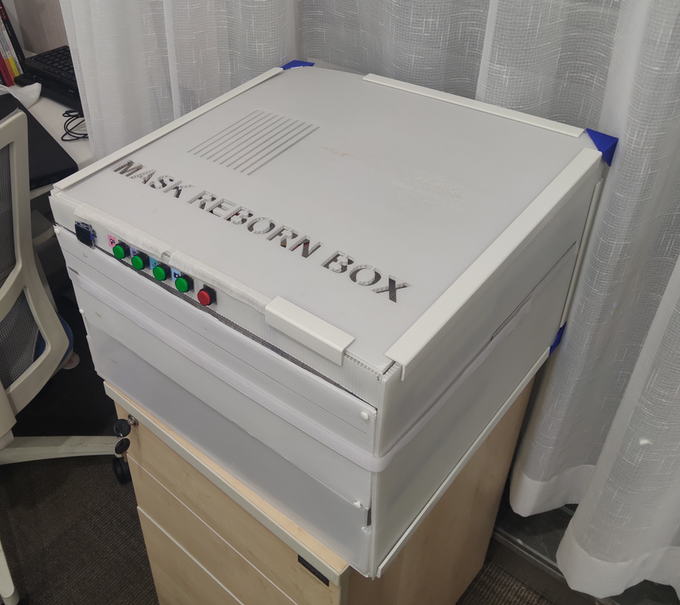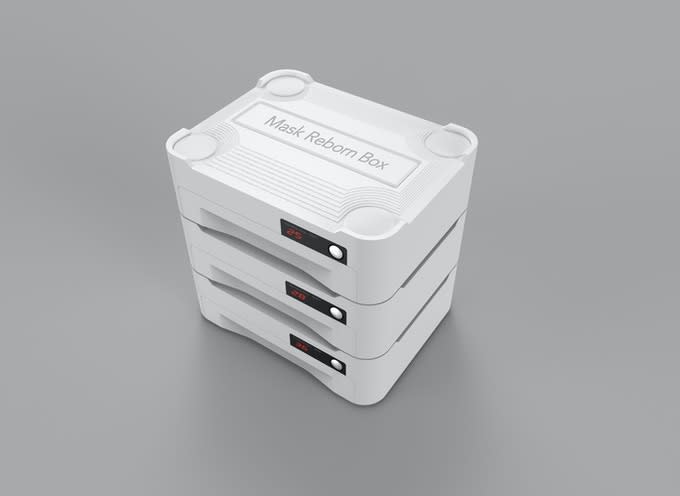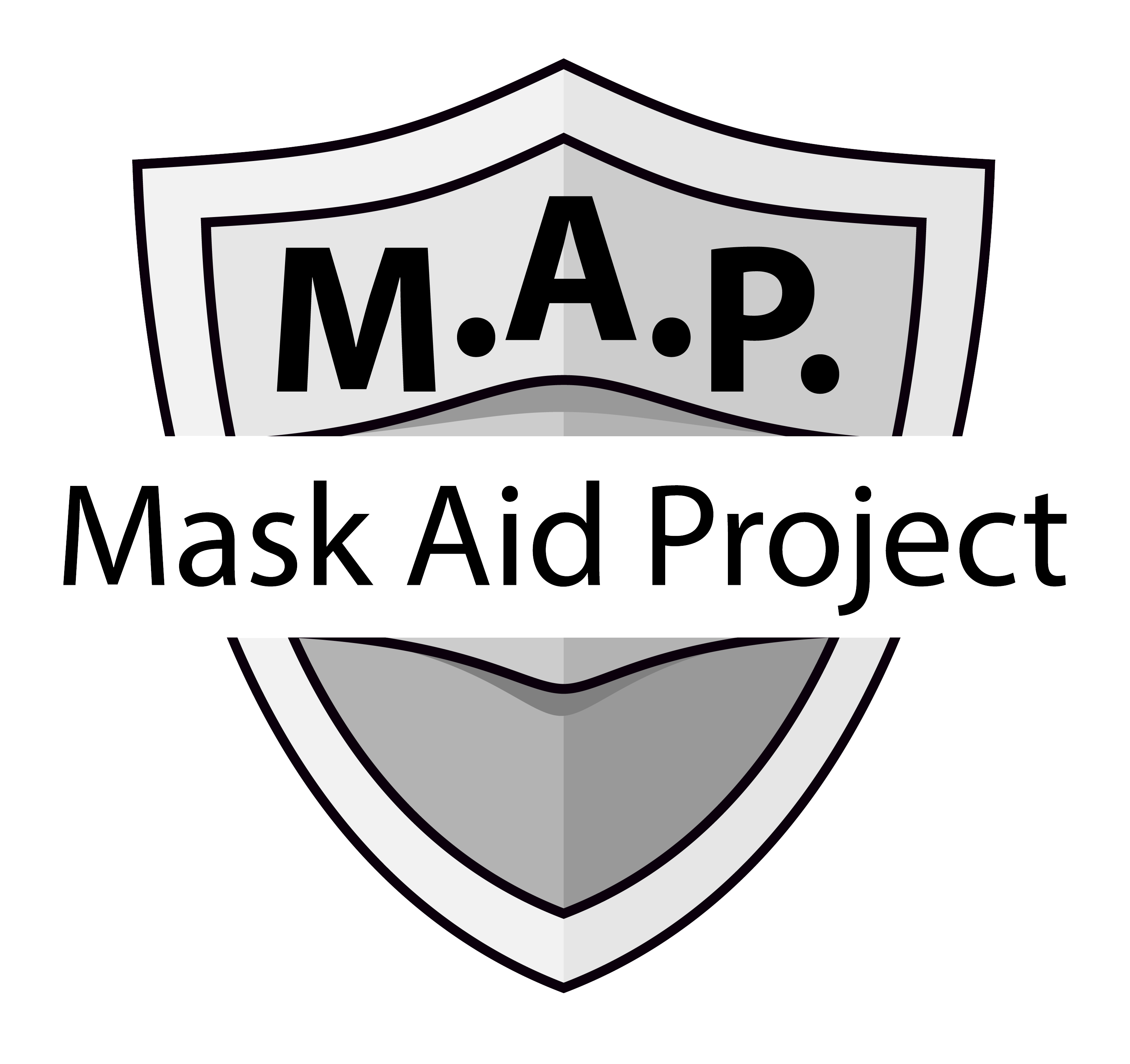(Chinese press about the project here)
We created a box that renews protective masks and respirators. To help everyone with the PPE (personal protective equipment) shortage, we designed our box to be low-maintenance, affordable, and fool-proof. With this kit, you can join the fight against the pandemic by sanitizing masks.

Our device uses an effective, proven, and tested four-step process to clean, dry, sanitize, and most importantly, re-apply a static charge to an otherwise disposable mask. Here is the process:
- First, we wash the mask in hot water at 60º Celsius for 30 minutes. This step is only used when the mask is visibly dirty or difficult to breathe through as it tends to shorten the life of the mask.
- Next, we dry it with hot air at 60º for 30 minutes to sanitize it.
- Meanwhile (or separately), we expose the mask to UVC light which further sanitizes the mask killing 99% of bacteria and viruses like COVID-19. This is done either at the same time or as a separate 30-minute process depending on the model.
- Finally, we apply electricity to renew the static charge.
We designed our device to be easily assembled or disassembled. When it is not in use, it can be folded down for easy storage and packaging. We will offer a version of the kit where you can build your own enclosure allowing you to re-use whatever material you have on hand.
Why we built the Mask Reborn Box
The world has suffered a lot from the Coronavirus. We wanted to do our part in helping people with this pandemic (as well as possible future pandemics).
Since there is so much unknown about this novel virus, people are understandably fearful. With so much uncertainty, getting as many protective masks as you can is actually a very rational thing to do! But what is good for the individual is not always good for society. While hoarding is understandable, given everyone’s fears, it has caused a global shortage of masks that medical professionals and others require. The WHO and other organizations recommend only wearing masks sparingly, even though the world would be safer if everyone were to wear a proper mask.
To compound the problem, people with fewer resources are finding it harder to get proper protection. But viruses don’t care about your race or social status. Neither do we. We believe that everyone has the right to protective equipment. We hope to get our box in the hands of as many people as possible.
Environmental Impact
If we were to use disposable masks as they were meant to be used, that would mean using 3.2 billion masks a day. So if you were to use masks properly, you would need to dispose of your old mask and use a new one every 4 hours. This adds up to 3.2 billion new masks every day. That is a lot of landfill!
With our kit, we can cut that number dramatically by reusing these masks instead of them ending up in a landfill, clogging out sewers, or in our oceans.
Another way we show our commitment to the environment is by using PP boards as the shell. The boards can biodegrade in soil or be disposed of by being burnt without releasing any toxic chemicals.
We also plan on using the ENIG technique to manufacture our control boards which minimizes lead pollution. We will also find ROHS certified factories to manufacture the enclosure.
Our Research
There are ways to safely wash and sanitize disposable masks at home, but most people don’t do it properly. And when they do, it removes the essential static charge on the surface of the mask. Although our box will work with any disposable mask, it is especially useful for the N95 mask because of the recharging step.
You have probably heard of the N95 mask. It is one of the most common and effective masks people use to help protect themselves from viruses. It is also very hard to get currently because it is in high demand. It’s officially called the N95 FFR. The weird numbers and letters are the classification that the U.S. National Institute for Occupational Safety and Health uses. The FFR stands for Filtering Facepiece Respirator, the N is ‘Not oil-resistant’ (there is also R and P for oil-Resistant and oil-Proof), the 95 means it filters out at least 95% of airborne particles. It was developed in the 1970s for industrial use but became a healthcare standard in the 1990s when a team lead by Tennessee professor Peter Tsai invented a novel way to embed static electricity into non-woven fabric. It proved to be world-changing virus-blocking technology that is now a global standard (here is a link to how this technology came about).
We researched how these masks work and discovered that the key reason these masks stop working is that the static charge dissipates. We made this video below to give you a simplified explanation of how a static charge helps make masks block particles while maintaining breathability.
The method we use in the Mask Reborn Box is in accordance with paper “Guidelines of Reusing Masks by Electrostatic Recharging During COVID-19” by Jianfeng Chen of the Beijing University College of Chemical Engineering, and as outlined by a paper by Stanford University researchers entitled “Can N95 respirators be reused after disinfection? And for how many times?.” The process is outlined in this video:
We used professional meters to make sure the static charge was adequate and even surpassed standards outlined in the papers above (you can find videos and more information on our website).
Test Result Video (long):
The video above shows that with our method, we were able to successfully re-apply static charge and restore the filtering of PM0.3 particulate matter to used masks. Results below:

The Boxes
We are building 2 different versions of the PMRB (Pre-production Mask Reborn Box):
- Semi-PMRB – A portable, modular box that can renew 1 mask at a time.
- PMRB – A large desktop model that can renew up to 6 masks at a time.
The Semi-PMRB

This Semi-PMRB is made out of polypropylene (PP) boxes (in the demo video the mock-up uses cardboard and not PP). Since there are 4 modules in this kit, you can potentially have 4 masks being processed in the box at any given time.
This kit has 2 different timer types available; one either an analog or a digital timing mechanism. The analog timer uses a dial allowing you to manually set the timing. The digital model runs for a set amount of time depending on what step you are on. Both kits will automatically stop the various processes when the timer stops.
Why 2 designs? Other than the $5 difference, they both take the same amount of resources to build and assemble. Also, by choosing the model you want, you get to help us with market research!
Semi-PMRB analog timer:
With the analog timer, you turn a dial to select the amount of time.
Semi-PMRB digital timer:
The digital timer offers accurate and preset parameters.
The PMRB
The PMRB model has a larger footprint and a greater capacity. It can take 6 masks at a time in the drying, UVC, and recharge stages, but up to 12 masks in the washing stage. It also has a different PCB board and layout for the controls. This one is only available with a digital timer.

If we reach a stretch goal of $100,000, the PMRB box will have a molded case something like the image below:

The final product will be made out of molded plastic, but the current model is made out of PP. If we reach our stretch goal, your order can be upgraded to molded plastic. If you are a maker, you can also have the option to build the enclosure yourself. Because of the size of the package, this also saves you a lot on shipping. But don’t worry – we’ll send you the parts and instructions on how to build the enclosure yourself. You can use polypropylene, cardboard, or whatever material you have on hand that you want to experiment with.
Our Team

We are an international team of makers, inventors, and designers brought together to help the world in a time of crisis. We all had different experiences that brought us together.
Torrey Nommesen is an American living in Xi’an, China. When the early stage of the breakout happened, he left to visit South Africa to wait out what seemed like a flu that only affected Wuhan China. He was planning on traveling for a little while until the disease was under control and he could come back to work in Xi’an. However, his vacation only lasted a few weeks before the pandemic became global and South Africa went on lockdown. He is currently stuck in Cape Town, South Africa until he can get a flight to either China or the United States. He has been a long time friend and colleague of Kalimorv, so when he was asked to become part of the team, he joined without hesitation.
Kalimov Lok is a Macanese maker who lives in Shanghai. Since his mother has a background in bioengineering, she had the foresight to get him a stock of medical masks before most people knew it would become a problem. He quickly realized that everyone was going to need masks. He calculated that a global pandemic would mean that we need 3.7 billion masks every single day. Later officials calculated that number to be 3.2 billion. At first, he was intent on sitting at home and waiting out the pandemic, but one day he noticed an online merchant taking advantage of the situation by selling masks of questionable quality at exorbitant prices. As an inventor, he decided that he could do something about it. A lot of makers in his community were starting to learn and share knowledge about how masks work. He discovered that most masks had an Achilles’ heel in that they would need a static charge to work properly. Since his passion is electronics, he decided that there had to be a way to solve this issue.
Meanwhile, Jason Leong was trapped with his family in Yichang, Hubei near Wuhan – ground zero of the early stage of the virus. Having heard about Kalimorv’s efforts, he realized that he could help. Kalimorv had an electronics lab and Jason had a lot of material knowledge to help select and order supplies. When the Hubei lockdown was over, Jason quickly drove back to his home town of Guangzhou, a thousand kilometers away. There he was able to work in his lab more effectively.
With the help of a global network of maker communities to help with research, surveys, collecting data, and analysis, we tested different sketches and blueprints. On May 1st, the team participated in the MIT Hackathon Challenge “Africa Takes on COVID-19.”
Halima Ouatab joined the team from Morocco during the hackathon. She brought her expertise in global market chains. Because of COVID-19, she had to pause her studies, terminate her internship, and stay away from her family. She watched as the situation worsening and her community suffered. Halima was key in extending our perspective to include Africa. She encouraged us to find a solution that takes into account the underprivileged, reasoning that if we can address the needs of developing countries first, then it would be easier to modify our product for a global market.
During the hackathon, we successfully finalized not one, but 2 different working prototypes. We were able to create a proof of concept for our methods to show that we could successfully restore masks with our box. We have continued to upgrade or design after the challenge making the prototype safer and easier to use. We are now ready for our next challenge: to show the Mask Reborn Box to the world.
